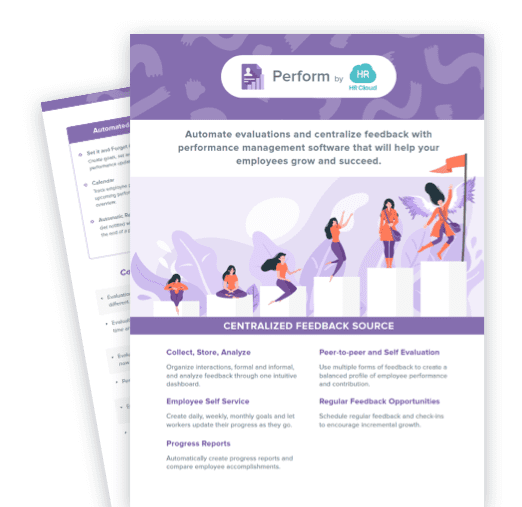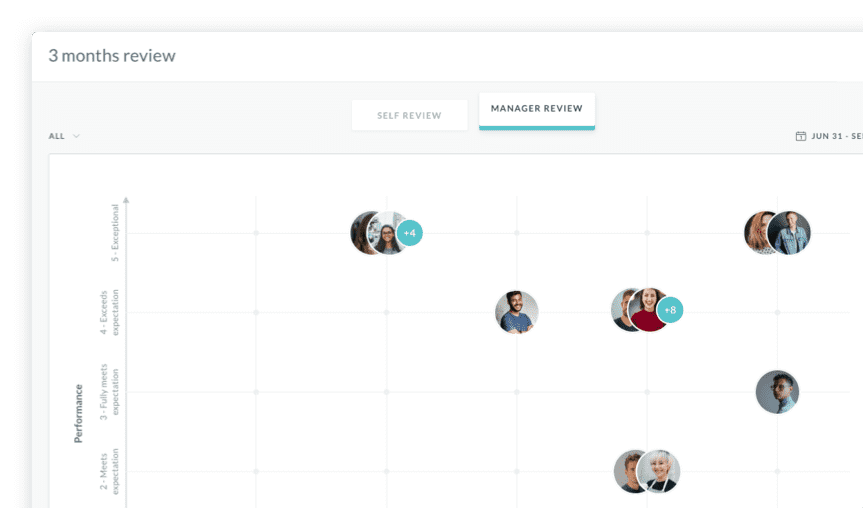Performance Cycle: How It Can Boost Employee Performance
.png)


 Cut onboarding time
by 60%—here's the
Ultimate Checklist
that helped do it.
Cut onboarding time
by 60%—here's the
Ultimate Checklist
that helped do it.

The performance cycle is a crucial framework for optimizing employee performance within organizations. By implementing an effective management cycle, companies can enhance individual productivity and drive overall success.
With HR Cloud®, simplifying performance management becomes seamless and offers you a competitive edge. Take a look at our Performance Management Software.
How can your organization benefit from it? Let’s find out.
What is a Performance Cycle?
It refers to a series of activities and processes that aim to set clear goals, evaluate progress, provide feedback, and facilitate employee growth and development. It serves as a roadmap for both managers and employees to align their efforts, monitor performance, and identify areas for improvement.
In the following sections, we will delve deeper into the components of the performance cycle and explore how each element contributes to optimizing employee work quality and well-being.
Components
The performance cycle is a systematic approach to managing employees. It consists of several key components that work together to create a cohesive process:
-
Goal Setting: This involves defining clear and specific objectives for individual employees or teams. Well-defined goals give employees direction and focus, aligning their efforts with the organization's strategic objectives.
-
Performance Evaluation: In this stage, managers assess employees' performance against the established goals and predetermined criteria. These evaluations serve as an opportunity to measure progress, identify strengths and areas for improvement, and make informed decisions regarding employee development and rewards.
The role of clear expectations, regular check-ins, and performance metrics
Clear expectations are crucial. Employees must understand what is expected of them and how their work will be evaluated.
Regular check-ins, such as one-on-one meetings between managers and employees, are vital in the performance cycle. These meetings provide an opportunity to discuss progress, address challenges, and offer support. Regular check-ins foster open communication, strengthen relationships, and enable managers to provide timely feedback and guidance.
Performance metrics are essential tools in the performance cycle. By establishing measurable indicators, organizations can objectively assess quality and track progress. These metrics provide a quantitative basis for evaluating achievements and identifying improvement areas.

To learn more about Perform by HR Cloud, download one pager now
Download nowSetting Clear Goals
Setting clear and achievable employee goals is crucial for their performance and success. Well-defined goals provide direction, motivation, and a sense of purpose, empowering employees to perform at their best. Let's explore the importance of clear goals and how they drive employee work quality.
Importance of setting clear and achievable goals:
-
Motivation and Focus: Clear goals give employees a sense of purpose and direction. When employees clearly understand what they need to achieve, they are more motivated to work towards those goals. Clarity helps them prioritize tasks, stay focused, and channel their efforts toward meaningful outcomes.
-
Enhanced Performance: Well-defined goals give employees a clear vision of success. Employees can effectively align their efforts and resources by knowing what is expected of them. This alignment enhances their work as they strive to meet or exceed the defined targets.
-
Improved Communication and Alignment: Clear goals facilitate effective communication between managers and employees. When goals are transparently communicated, employees can seek clarifications, discuss challenges, and collaborate with their managers to align their individual goals with the organization’s broader objectives.
Regular Performance Check-ins
Regular check-ins and one-on-one meetings between managers and employees play a crucial role in maximizing employee output. These interactions provide opportunities to monitor progress, address challenges, offer guidance, and foster a supportive work environment. Let's explore the significance of regular check-ins and how they contribute to employee development and output.
The significance of regular performance check-ins:
-
Monitoring Progress: Monitoring progress helps managers identify early signs of success or potential issues and take timely action.
-
Addressing Challenges: Regular check-ins create a safe space for employees to seek advice and collaborate on finding solutions to enhance their work process.
-
Providing Guidance and Support: One-on-one meetings allow managers to provide guidance, share expertise and offer suggestions for improvement. Managers can act as mentors, offering support and personalized development opportunities to foster employee growth. Hard work shouldn't go unnoticed.

The importance of open communication, active listening, and constructive feedback:
-
Establishing a supportive and trusting environment: When employees feel comfortable sharing their challenges, concerns, and aspirations, managers can better understand their needs and provide appropriate support. A supportive environment promotes engagement, satisfaction, and collaboration.
-
Discussing achievements and areas for improvement: Acknowledging accomplishments boosts staff morale, reinforces positive behaviors, and motivates employees to maintain their output. Additionally, discussing areas for improvement constructively helps employees identify their development needs and encourages a growth mindset.
Implementing an Effective Review
This process requires a thoughtful approach that involves various strategies and considerations. Organizations can optimize their performance management cycle by gaining leadership buy-in, involving employees, providing ongoing training, and leveraging technology solutions. Let's explore these strategies in detail.
Strategies for implementing an effective management cycle:
-
Leadership Buy-in: When leaders are committed to the process and actively promote its importance during the planning stage, it sets a tone for the entire organization. Leaders should communicate the benefits, allocate resources, and lead by example.
-
Employee Involvement: Involving employees in the management cycle empowers them to take ownership of their development goals. Encourage employees to actively participate in setting their objectives, providing input during discussions, and seeking opportunities for growth. Creating a collaborative environment where employees have a voice fosters engagement and accountability.
-
Ongoing Training and Development: Managers should receive training on effective management techniques, such as providing feedback, coaching, and conducting discussions. Employees can benefit from training on goal setting, self-assessment, and professional development opportunities.
Leadership Support and Involvement
When leaders actively participate in the process, set the tone, and reinforce expectations, it creates an excellence and accountability culture. Let's explore the need for leadership support, how leaders can actively participate in the management cycle, and the benefits of a collaborative approach between managers and employees.
The need for leadership support and involvement:
-
Setting the Tone: Leaders should communicate the expectations, values, and benefits associated with the management cycle to create a performance-driven culture.
-
Reinforcing Expectations: Leaders are responsible for reinforcing expectations throughout the organization. They can emphasize the importance of goal setting, continuous improvement, and professional development.
-
Actively Participating in the Process: Leaders should actively participate in the process to demonstrate their commitment. This can include conducting discussions with their direct reports, providing constructive feedback, and recognizing and rewarding exceptional feats.
Benefits of a collaborative approach between managers and employees:
-
Enhanced Communication and Alignment: A collaborative approach between managers and employees promotes open communication and ensures alignment of goals and expectations. When managers actively listen to employees' perspectives, concerns, and aspirations, it fosters trust and understanding. Employees feel valued and heard, which leads to increased engagement and commitment to their performance goals.
-
Shared Ownership and Accountability: Collaboration empowers employees to take ownership of their performance. By involving employees in goal setting, self-assessment, and growth planning, they become active participants in the performance management cycle. This shared ownership cultivates a sense of accountability and responsibility for their performance outcomes.
Employee Engagement and Development
Employee engagement and development are vital components of a successful performance management cycle. When employees are actively engaged and provided with opportunities for growth and development, it enhances their performance and contributes to the organization’s overall success. In fact, social proof statistics show that companies that prioritize employee engagement and development experience a significant increase in productivity when compared to organizations that neglect these aspects.
The importance of employee engagement and development in the performance management cycle:
-
Enhanced Output: Engaged employees are likelier to perform at their best. Employees who feel motivated, valued, and connected to their work are driven to achieve their goals and contribute to organizational success.
-
Retention and Satisfaction: Employees who feel supported in their growth and see opportunities for advancement are more likely to remain committed to the organization. Engaged and satisfied employees contribute to a positive work environment, teamwork, and higher productivity.
-
Continuous Learning and Adaptability: Organizations can foster a culture of continuous learning and adaptability by offering opportunities for skill enhancement, knowledge sharing, and personal growth. Engaged employees embrace new challenges, seek innovative solutions, and contribute to a culture of improvement.
Benefits of encouraging employees to take ownership of their growth:
-
Increased Motivation and Commitment: When employees take ownership of their growth, they feel a sense of pride and ownership in their work. This increases their motivation and commitment to achieving their goals and delivering high-quality results.
-
Personalized Development: Encouraging employees to take ownership of their growth allows for personalized development paths. Employees can identify their strengths, weaknesses, and areas of interest to tailor their development plans accordingly.
-
Career Advancement: Employees who actively own their growth are more likely to progress in their careers.
Conclusion
Implementing an effective cycle is vital for organizations aiming to optimize employee output at business, enhance job satisfaction, improve company culture, and drive overall success. Organizations create a framework for continuous improvement, employee development, and increased productivity by establishing a culture that values the performance management cycle. Embracing the monitoring cycle as a strategic tool contributes to a positive work environment, fosters employee engagement, and positions organizations for long-term growth and success.
Is Your Company's Culture
Working Against You?
culture with our short quiz.
Author Bio:
Joe Troyer - I’m one of the founders of Virtual Valley and Digital Triggers. He is a leading expert in all things Internet Marketing: Pay Per Click Marketing, Search Engine Optimization, Google Business, Reputation Management, Landing Page Conversion, and Call Tracking.
Keep Reading
45 Boss Day Messages That Actually Mean Something (2026 Guide)
When is Boss Day 2026? Mark your calendar for October 16, 2026 — the annual opportunity
Birthday Wishes for Coworkers: 50+ Messages That Build Workplace Connection
A coworker's birthday isn't just another calendar date—it's a meaningful opportunity to
Embracing Diversity: Recognizing Different Cultures in the Workplace
Workplaces today reflect the incredible diversity of the world around us. People bring
Like What You Hear?
We'd love to chat with you more about how HR Cloud® can support your business's HR needs. Book Your Free Demo

Build a Culture of Recognition. Boost Engagement. Guaranteed.
Workmates empowers employees to stay informed, connected, and appreciated—whether they’re on the front line, in the office, or remote. Recognition drives 12x higher engagement.Trusted by industry leaders in every sector




Cut Onboarding Costs by 60%.
Take the confusion and follow-ups out of onboarding with automated workflows, digital forms, and structured portals—so new hires ramp faster 3X quicker.Trusted by industry leaders in every sector




